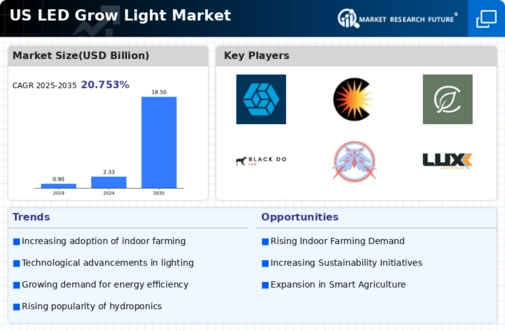Energy Efficiency Regulations
Stringent energy efficiency regulations in the US are driving the adoption of led grow-lights across various sectors. The government has implemented policies aimed at reducing energy consumption and promoting sustainable practices. As a result, growers are increasingly turning to led technology, which offers substantial energy savings compared to traditional lighting systems. Reports suggest that led lights can reduce energy usage by up to 50%, making them an attractive option for both commercial and residential growers. This regulatory push not only enhances the appeal of the led grow-light market but also aligns with broader environmental goals, encouraging more growers to transition to energy-efficient lighting solutions.
Rising Indoor Farming Practices
The increasing adoption of indoor farming practices in the US is a pivotal driver for the led grow-light market. As urbanization continues to rise, more individuals and businesses are turning to indoor farming to maximize space and produce fresh crops year-round. This trend is further supported by the growing demand for locally sourced food, which has led to a surge in vertical farming and hydroponics. According to recent data, the indoor farming market is projected to reach approximately $10 billion by 2026, indicating a robust growth trajectory. Consequently, the led grow-light market is likely to benefit significantly from this shift, as efficient lighting solutions are essential for optimizing plant growth in controlled environments.
Expansion of E-commerce Platforms
The expansion of e-commerce platforms is reshaping the distribution landscape for the led grow-light market. With more consumers turning to online shopping for gardening supplies, the accessibility of led grow-lights has increased significantly. E-commerce allows for a wider range of products to be available to consumers, including specialized lighting solutions that may not be found in local stores. This shift is particularly beneficial for niche markets, such as urban gardeners and hobbyists, who seek tailored solutions for their specific needs. As online sales continue to grow, the led grow-light market is likely to see a corresponding increase in demand, driven by the convenience and variety offered by e-commerce.
Increased Awareness of Plant Health
There is a growing awareness among consumers and growers regarding the importance of plant health and the role of lighting in achieving optimal growth. This awareness is driving demand for advanced led grow-lights that can provide specific light spectrums tailored to different plant species. Research indicates that the right light spectrum can enhance photosynthesis, leading to healthier plants and higher yields. As a result, the led grow-light market is experiencing increased interest from both hobbyist gardeners and commercial growers seeking to improve their crop quality. This trend is likely to continue as education around plant care and the benefits of specialized lighting becomes more widespread.
Technological Innovations in Lighting
Technological innovations in lighting are significantly influencing the led grow-light market. The development of smart lighting systems, which can be controlled remotely and programmed for specific growth cycles, is gaining traction among growers. These advancements allow for precise control over light intensity and duration, optimizing plant growth conditions. Furthermore, the integration of sensors and automation in lighting systems is enhancing efficiency and reducing labor costs. As these technologies become more accessible, the led grow-light market is poised for growth, attracting both new entrants and established players looking to capitalize on the demand for high-tech growing solutions.






















Leave a Comment